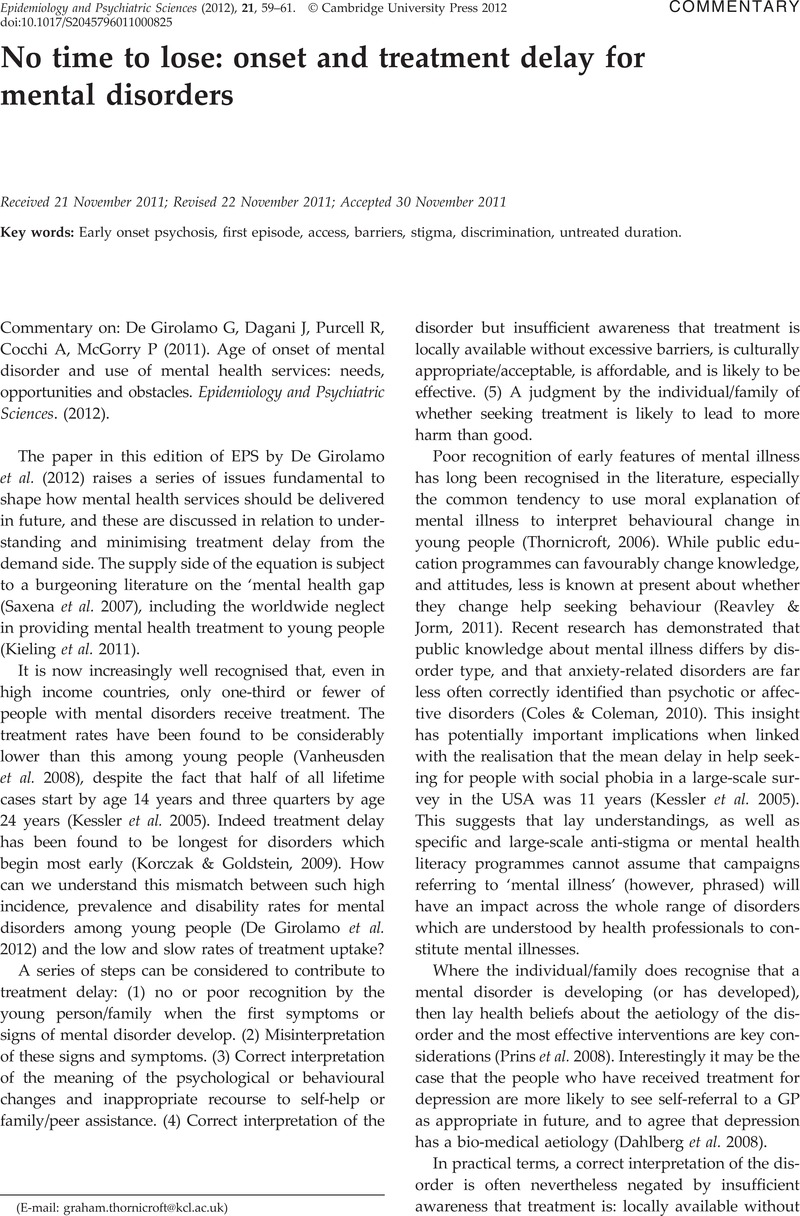Crossref Citations
This article has been cited by the following publications. This list is generated based on data provided by Crossref.
Lasalvia, Antonio
and
Tansella, Michele
2012.
‘Young people at high risk for psychosis: conceptual framework, research evidence and treatment opportunities’.
Epidemiology and Psychiatric Sciences,
Vol. 21,
Issue. 4,
p.
317.
Gallo, Kaitlin P.
Comer, Jonathan S.
and
Barlow, David H.
2013.
Direct-to-consumer marketing of psychological treatments for anxiety disorders.
Journal of Anxiety Disorders,
Vol. 27,
Issue. 8,
p.
793.
Yap, M. B. H.
Reavley, N. J.
and
Jorm, A. F.
2014.
The associations between psychiatric label use and young people's help-seeking preferences: results from an Australian national survey.
Epidemiology and Psychiatric Sciences,
Vol. 23,
Issue. 1,
p.
51.
Rüsch, N.
Müller, M.
Ajdacic-Gross, V.
Rodgers, S.
Corrigan, P.W.
and
Rössler, W.
2014.
Shame, perceived knowledge and satisfaction associated with mental health as predictors of attitude patterns towards help-seeking.
Epidemiology and Psychiatric Sciences,
Vol. 23,
Issue. 2,
p.
177.
Gee, Donna
Mildred, Helen
Brann, Peter
and
Taylor, Mandy
2015.
Brief Intervention: A Promising Framework for Child and Youth Mental Health?.
Administration and Policy in Mental Health and Mental Health Services Research,
Vol. 42,
Issue. 2,
p.
121.
Dockery, Lisa
Jeffery, Debra
Schauman, Oliver
Williams, Paul
Farrelly, Simone
Bonnington, Oliver
Gabbidon, Jheanell
Lassman, Francesca
Szmukler, George
Thornicroft, Graham
and
Clement, Sarah
2015.
Stigma- and non-stigma-related treatment barriers to mental healthcare reported by service users and caregivers.
Psychiatry Research,
Vol. 228,
Issue. 3,
p.
612.
Jörg, Frederike
Visser, Ellen
Ormel, Johan
Reijneveld, Sijmen A.
Hartman, Catharina A.
and
Oldehinkel, Albertine J.
2016.
Mental health care use in adolescents with and without mental disorders.
European Child & Adolescent Psychiatry,
Vol. 25,
Issue. 5,
p.
501.
Raven, D.
Jörg, F.
Visser, E.
Oldehinkel, A. J.
and
Schoevers, R. A.
2017.
Time-to-treatment of mental disorders in a community sample of Dutch adolescents. A TRAILS study.
Epidemiology and Psychiatric Sciences,
Vol. 26,
Issue. 2,
p.
177.
Huỳnh, Christophe
Caron, Jean
Pelletier, Marilou
Liu, Aihua
and
Fleury, Marie-Josée
2018.
A Developmental Perspective in Mental Health Services Use Among Adults with Mental Disorders.
The Journal of Behavioral Health Services & Research,
Vol. 45,
Issue. 3,
p.
389.
Anderson, Daniel
Choden, Tsering
Sandseth, Tracy
Teoh, Tricia
Essock, Susan M.
and
Harrison, Myla E.
2019.
NYC START: A New Model for Securing Community Services for Individuals Hospitalized for First-Episode Psychosis.
Psychiatric Services,
Vol. 70,
Issue. 8,
p.
644.
Minaeva, Olga
Riese, Harriëtte
Lamers, Femke
Antypa, Niki
Wichers, Marieke
and
Booij, Sanne H
2020.
Screening for Depression in Daily Life: Development and External Validation of a Prediction Model Based on Actigraphy and Experience Sampling Method.
Journal of Medical Internet Research,
Vol. 22,
Issue. 12,
p.
e22634.
Kelly, Erin Veronica
Grummitt, Lucinda Rachel
Birrell, Louise
Stapinski, Lexine
Barrett, Emma Louise
Boyle, Julia
Teesson, Maree
and
Newton, Nicola Clare
2021.
The school-led Preventure study: Protocol of a cluster-randomised controlled trial of effectiveness to prevent adolescent alcohol misuse, internalising problems, and externalising problems through a personality-targeted intervention delivered by school staff.
Preventive Medicine Reports,
Vol. 21,
Issue. ,
p.
101286.
Batterham, Philip J
Gulliver, Amelia
Heffernan, Cassandra
Calear, Alison L
Werner-Seidler, Aliza
Turner, Alyna
Farrer, Louise M
Chatterton, Mary Lou
Mihalopoulos, Cathrine
and
Berk, Michael
2024.
A Brief Workplace Training Program to Support Help-Seeking for Mental Ill-Health: Protocol for the Helipad Cluster Randomized Controlled Trial.
JMIR Research Protocols,
Vol. 13,
Issue. ,
p.
e55529.
Tan, Rachel Hsiao Shen
Koh, Yen Sin
Vaingankar, Janhavi Ajit
Abdin, Edimansyah
Sambasivam, Rajeswari
Chong, Siow Ann
and
Subramaniam, Mythily
2024.
Treatment delays for mental disorders in Singapore: results from the Singapore Mental Health Study 2016.
Social Psychiatry and Psychiatric Epidemiology,
Vol. 59,
Issue. 2,
p.
375.
Pettus, Carrie
Kennedy, Stephanie C.
Renn, Tanya
Tripodi, Stephen
Herod, Lauren
Rudes, Danielle
and
Taxman, Faye S.
2024.
Behavioral health literacy: A new construct to improve outcomes among incarcerated individuals.
International Journal of Social Welfare,
Vol. 33,
Issue. 2,
p.
564.



